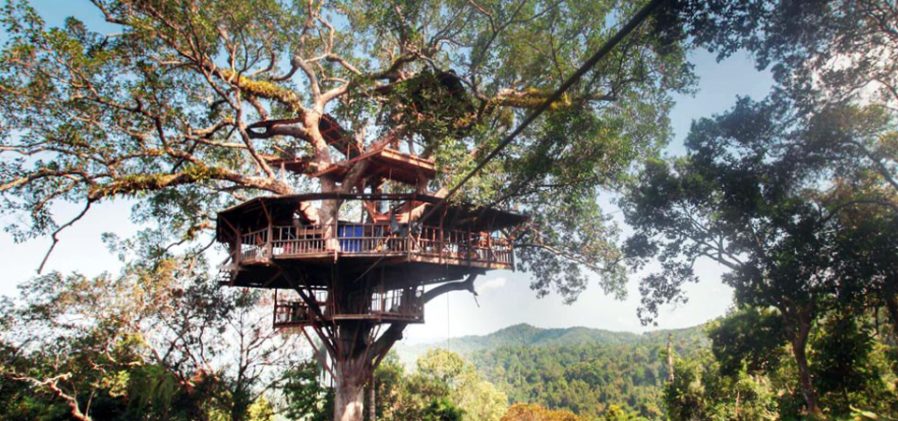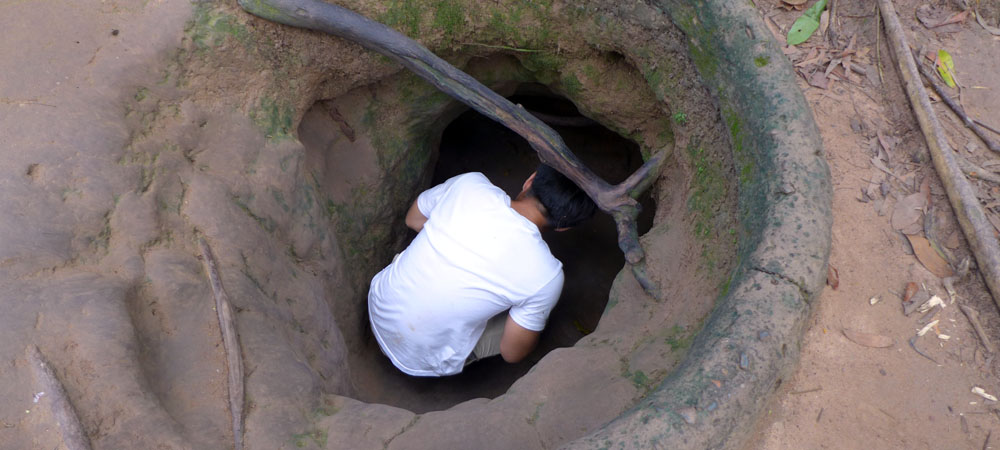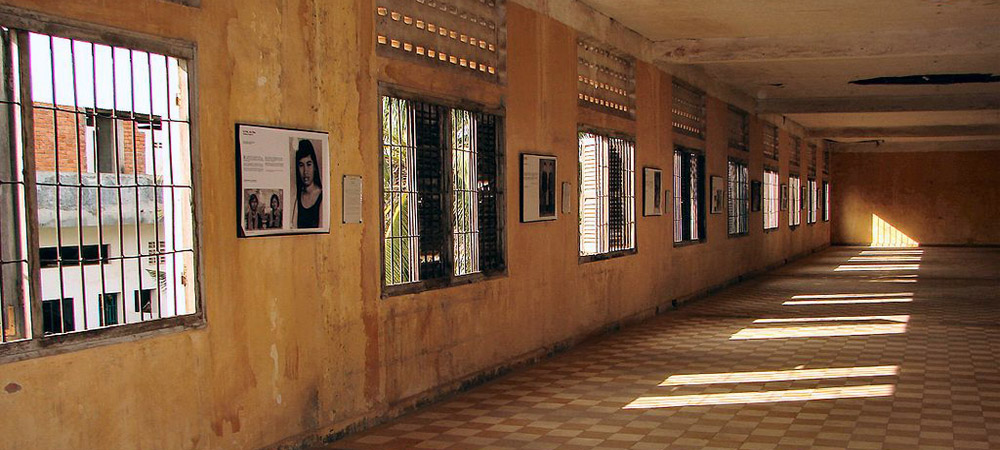When most people think of South East Asia it can be easy to imagine ornate temples, floating markets on the Mekong or island life unhampered by the stresses of the west. While these sites and experiences are some of the best parts of South East Asia, there is a whole other side of the region. Throughout the area from Myanmar through Laos, into Thailand and Vietnam and beyond there are unique experiences that you won’t be able to find anywhere else in the world. The following is a roundup of our favorite things to do that are unique specifically to South East Asia.
The Gibbon Experience, Laos
Nestled against the border with Thailand in the very North West corner of Laos is the riverside town called Huay Xai, home to one of the most unique experiences in the region – the “Gibbon Experience”. Living high in canopied trees, Gibbons are small primates with long arms and hands that stand about half the size of a full grown average human with large throat sacs through which they sing to both attract mates and defend their territories. Many Gibbons are brown to black with white markings on their faces, hands and feet. Unfortunately, Gibbons are rarely still seen in the wild and are critically endangered. So the Gibbon Experience is the only place in the region (if not the world) where you can live like a Gibbon for a day or two. Staying in the world’s tallest treehouses means you will get to experience living in the high crested canopies away from the hustle and bustle of town life, waking up only to the sounds of nature before using zip lines to get from tree house to tree house for meals and excursions into the forest.
Created as an eco-sustainable project, the Gibbon Experience has paved the way for the creation of the Nam Kan National Park which now employs local hill tribe peoples such as the Hmong to patrol the forests as well as to work directly with the Gibbon Experience as knowledgeable guides, cooks and more. This has bought much needed revenue to local people and has helped conservation efforts. Finally, the Gibbon Experience gives the option of picking one of the three different tours catering to your individual needs and desires: “Waterfall”, “Classic” or “Express”. Each one utilizes zip lines to get from place to place – 15 kilometers of zip lines to be exact! It will really give you a sense of what life is like from the view point of the Gibbons as they move high above the jungle canopy. Two to three days at the Gibbon Experience can easily be added to any tour of the region that Explorient offers in order to create a truly memorable time in Laos.
Cu Chi Tunnels, Vietnam
This expansive network of tunnels that stretches throughout a huge portion of Vietnam was one of the ways that helped the Viet Cong to elude American troops and create a supply line to their troops during the Vietnam War. However, despite being a vital and logistical success, the tunnels would usually create squalid conditions alongside and it was often reported that many members of a battalion would be suffering from anything from malaria to typhoid and everything in between. Many men actually died in the tunnels as a result of their illnesses.
The Cu Chi tunnels are located in Ho Chi Minh City and make up just part of the overall network of tunnels that stretch around Vietnam, along the border with Laos and Cambodia. The inhabitants would come out of the tunnels under cover of darkness to look for food or to attack enemy troops before going back inside as a way to keep hidden. The US tried to destroy much of the tunnel network by dropping enormous amounts of bombs on the tunnels, as well as using the highly controversial “Agent Orange” in an attempt to kill all the trees that shrouded the tunnels. However, this was largely unsuccessful and many remained in place and subsequently provided a huge advantage to the Viet Cong.
Today, many areas of the tunnel network can be visited by tourists exploring Vietnam and you can even go inside some of the tunnels and see examples of booby traps that would have been set and used for invaders coming into the tunnels. The tunnels at Cu Chi are fascinating, since they are combined with an open air museum that features history about the region, and tourists can even eat a small meal similar to the ones the Viet Cong would have consumed while living in the tunnels. Also, underground conference rooms in which important battles such as the Tet Offensive were planned can be visited as part of the tunnel tour and you can even try your hand at firing off a couple of AK47, M16 or even smaller machine guns like the M60.
S21 And The Killing Fields, Cambodia
Simply put, “S-21” and the “Killing Fields” in Phnom Penh, Cambodia are the most harrowing of tourist attractions in the region. Indeed, even using the term ‘attraction’ to describe the site is somewhat of a misnomer, as all who come here come to see and understand the genocide that was set upon the Cambodian people by the Khmer Rouge. “S-21” – also known as Tuol Sleng (meaning “Poison Hill”) – was the prison used by the Khmer Rogue to house, torture and interrogate “enemies of the state”, the vast majority of which were completely innocent. This included even young woman and children. Today, S-21 has been preserved in relatively good condition, but it is made all the more spine-chilling by the fact that it was very clearly an abandoned school before the Khmer Rogue started using it as a prison. Visitors are free to walk around inside the buildings, and can see for themselves torture implements and the claustrophobic cells that were not much more than cages in where it was impossible for prisoners to stand up properly.
Other rooms in the buildings have been turned into small memorials and a small museum, describing the hellish conditions and showing the hundreds of black and white portrait photographs of the prisoners being processed before their imprisonment. This is made all the more haunting by the fact some of these faces are young children, some no more than 8 or 9 years old. So make no mistake, a visit to S-21 is emotionally intense and at times heart-breaking. This is not your regular “attraction”. However, few would argue that it is probably something that everyone should see if given the opportunity, if only because it may help prevent genocides and crimes against humanity of this nature from happening again. This goes the same for the Choeng Ek (lit. “Killing Fields”), about a 30-45 minute drive south of S-21, just outside the suburbs of Phnom Penh. A trip to S-21 is almost always combined with a trip to the Killing Fields immediately after, because after prisoners had a confession tortured out of them, they were sent there to be executed and buried in mass graves.
Walking around Choeung Ek today, you will see perhaps the most haunting memorial of all, and that is a Buddhist stupa that houses hundreds of skulls of the victims that spiral around upwards to the tip of its spire. Many of the skulls show the brutal ways of how victims were executed, including multiple fractures of what are clearly children’s skulls. Clubbing or suffocating victims to death with a plastic bag wrapped round their head were common methods of execution, because the Khmer Rogue soldiers were ordered “not to waste” precious ammunition. Some excavation of human remains is still ongoing as more mass graves are found, and so this only serves to make the whole experience even more shocking.
Although a visit to these sites makes for a harrowing and sobering experience, the Cambodian government today encourages all visitors to visit to help better understand the collective history of the country and its people. You will ultimately be glad you went in retrospect. Consider adding a trip to both “S-21 and “Choeung Ek” on your Cambodian itinerary with Explorient. Because if the temples of Angkor are a testament to humanity’s creativity, “S-21” and “Choeung Ek” are solemn reminders of humanity at its very worst. Experiencing both extremes will give you a much more genuine insight into Cambodia’s modern-psyche and its culture.
So whether you want to chill out in the jungles of Laos or you are more keen to explore the storied history of the area, one thing is for certain – any of these unique experiences is sure to leave you wanting more and coming back time and again.








